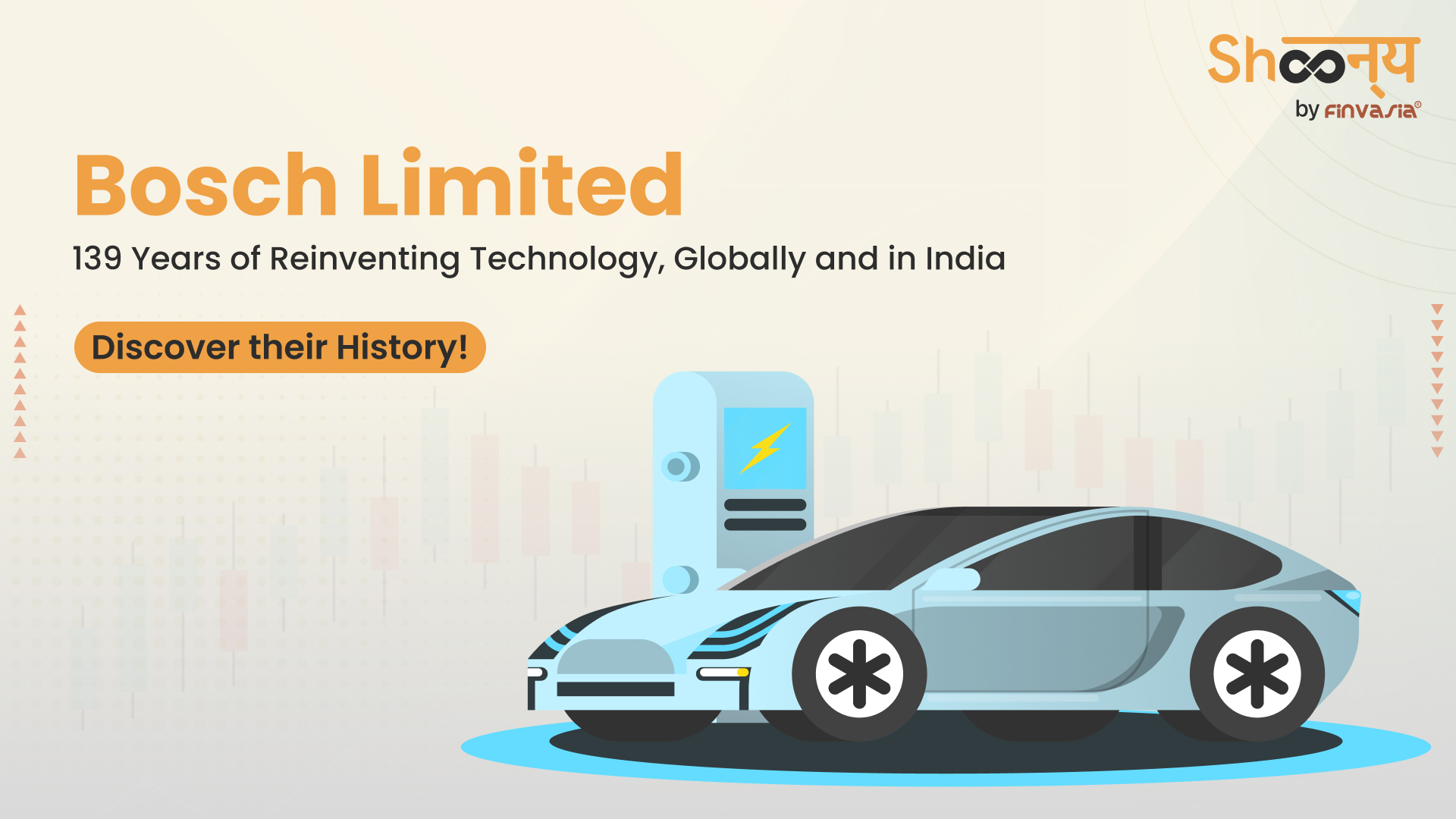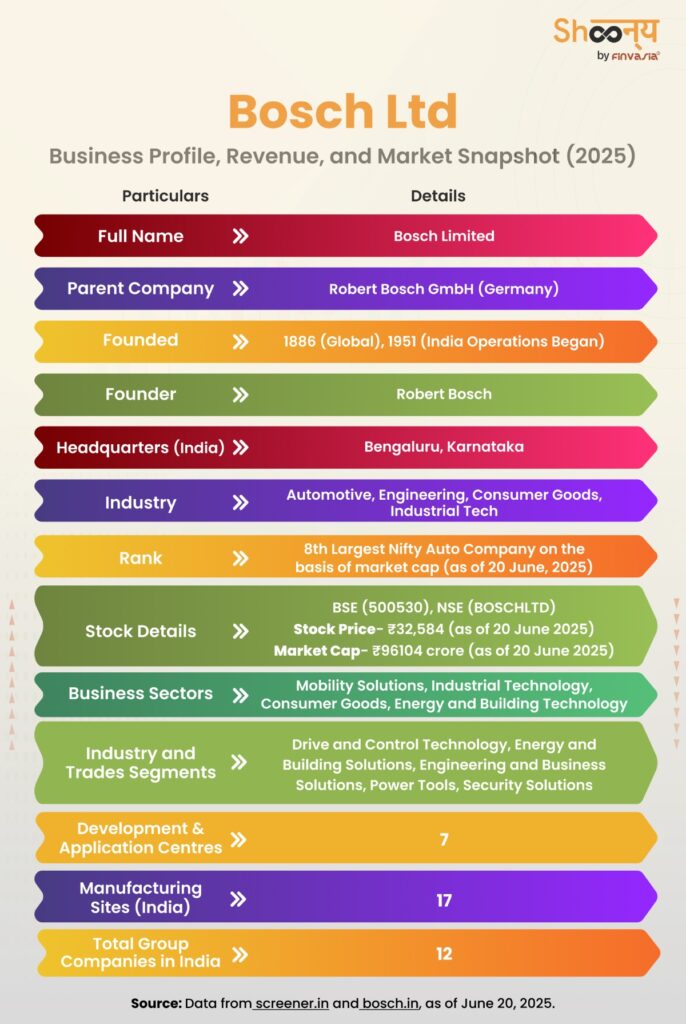Bosch Limited: 139 Years of Engineering That Shaped the Modern World

Bosch Ltd is one of those top Nifty Auto Index companies that powers a big part of our daily lives. From the engine in your Maruti to the drill in your local carpenter’s toolkit, Bosch has been building trust in India for decades. But this story didn’t start in India. It began in Germany over a century ago, with a small workshop and a vision that would eventually shape industries across the world.
What is the real history of Bosch Limited company and what is the current Robert Bosch revenue?
Let us explore it all!

Bosch Limited History: How a German Workshop Became a Household Name
In India, Bosch has evolved from being just a parts supplier to a name that touches homes, factories, and cities. This is the journey of Bosch Limited, how it entered India, grew with the country, and became a quiet giant in automotive, appliances, tools, and technology.
The Robert Bosch history began in 1886, when Robert Bosch opened his “Workshop for Precision Mechanics and Electrical Engineering” in Stuttgart. It was a man with a vision, a few tools, and relentless discipline.
The early years were rough. Robert Bosch himself described the beginnings as “a shambles.” But through the turbulence, a quiet revolution was brewing.
Back then, Bosch took on any work that came his way. He installed electric bells and telephone systems.
By 1897, Bosch started fitting improved magneto ignition devices into automobiles. And it worked. He became the only supplier of a reliable ignition system, earning the trust of a rapidly evolving automotive market.
But the real breakthrough came in 1902.
That year, Bosch’s chief engineer, Gottlob Honold, developed the high-voltage magneto ignition system with a spark plug. This invention would cement Bosch’s reputation as a world-leading automotive supplier.
Honold was the brain behind Bosch’s earliest innovations.
Robert Bosch himself said, “When Honold finished a new item and passed it to manufacturing, the Bosch world started clamoring for the finished product.”
Beyond ignition systems, Honold also brought lighting systems, horns, and starters into Bosch’s expanding product portfolio. His untimely death in 1923 left a void, but his work laid a foundation that would carry the company forward.
Meanwhile, Bosch had been moving his growing team from one location to another. Eventually, in 1901, he built the first dedicated Bosch factory.
. In 1905, to avoid customs duties and long shipping routes, Bosch opened a production facility in Paris, within sight of the Eiffel Tower. It was the company’s first manufacturing site outside Germany.
From 1906 to 1925, Bosch expanded rapidly across the globe. In 1908, the company opened its U.S. sales office in New York.
And then came India.
Bosch entered the Indian market in 1951, setting up its first manufacturing unit.
Bosch now operates through twelve companies in India, including Bosch Limited, Bosch Global Software Technologies Pvt. Ltd., Bosch Rexroth India, BSH Home Appliances, and more.
After the aggressive global strides made between 1906 and 1925.
The years from 1926 to 1945 brought both profound innovation and unimaginable adversity.
By 1927, Bosch had introduced its next defining invention, the diesel-injection pump. It came at a time when diesel engines, unlike gasoline engines, no longer needed magneto ignition. Initially fitted only in trucks, the diesel-injection pump for passenger cars was launched in 1936. This was the company’s second technological linchpin after the magneto ignition.
But the late 1920s also brought economic shocks.
From 1926 onward, it began expanding into new sectors. Some were extensions of existing work, such as power tools and thermotechnology. Others were bold new directions, including ventures into radio and television technology.
In 1927, Bosch engineer Hermann Steinhart came across a small device in his workshop — the “Forfex,” a hair-trimming machine with a built-in motor.
With the outbreak of the Second World War, Bosch shifted to military production.
Robert Bosch died in 1942, unaware that large parts of his factories would soon be destroyed in Allied bombings. By 1945, the company lay in ruins.
By the end of the war, more than 50 percent of Bosch’s German production facilities had been destroyed. The Allies had seen the company as a key wartime supplier and targeted it heavily. Bosch faced a shattered infrastructure and lost international sites — for the second time in its history.
But it didn’t stand still.
Reconstruction began with what was at hand. In the factory ruins, Bosch associates began making cooking pots from steel helmets, as well as handcarts and umbrellas. These items helped sustain families and reemploy workers. As conditions stabilized, Bosch returned to spark plug manufacturing for Allied military vehicles.
Though Robert Bosch was gone, his legacy was protected.
The 1950s also marked a return to the consumer market. Bosch tapped into the needs of postwar families. Kitchen appliances and DIY power tools became bestsellers. The Bosch food processor, launched as “Neuzeit,” became a staple in German and rural households alike. It grated, pressed, kneaded, and even peeled potatoes — a modern marvel for large families managing seasonal harvests.
In 1952, Bosch brought gasoline injection technology to passenger cars.
The same year, Bosch introduced the Bosch Combi, a versatile power tool designed for DIY users.
Hans Walz, Bosch’s successor, led the company until 1963.
By 1960, international sales had begun climbing again, finally crossing 20 per cent.
A company that once operated like a medium-sized enterprise now has over 70,000 associates. This called for structural change. So, Bosch began organizing itself into independent divisions, starting with Power Tools.
In 1967. It debuted in Volkswagen’s U.S. models to meet California’s strict emission norms. The success of Jetronic paved the way for Bosch to lead automotive electronics globally.
Another innovation came in 1976, the lambda sensor. Developed by Bosch to monitor exhaust oxygen levels, it enabled cleaner combustion and was the key to adopting three-way catalytic converters. This invention helped reduce harmful emissions by up to 90 percent.
Bosch also entered a new frontier: telecommunications. It began building tech for satellites, cell phones, and public networks in the 1980s.
In the 1990s, Bosch engineers began developing micromechanical sensors (MEMS). By 2005, Bosch started integrating them into smartphones and gaming devices. It also pioneered a plasma etching process to produce these microcomponents at scale. Today, Bosch manufactures over 4 million MEMS sensors per day, making it the global market leader.
- 1997: Common Rail diesel system — reduced fuel use, improved power.
- 2000: Gasoline direct injection.
- 2000s onward: Driver-assistance systems like Adaptive Cruise Control and Night Vision.
One surprising hit was the IXO electric screwdriver in 2003.
Then came the next leap — automated driving.
By 2015, Bosch was testing cars equipped with 360-degree high-speed cameras and radar systems. These vehicles could brake and accelerate automatically in traffic.
Bosch’s journey from a Stuttgart workshop in 1886 to a world leader in electronics, automotive, and consumer technology is a story of reinvention, again and again.
Even today, Bosch lives up to the words that shaped its DNA.
Bosch Ltd Overview: How a German Workshop Became a Pillar of Indian Industry
In India, Bosch is a leading supplier of technology and services in the areas of Mobility Solutions, Industrial Technology, Consumer Goods, and Energy and Building Technology.
Additionally, Bosch has in India the largest development center outside Germany, for end-to-end engineering and technology solutions.
- Bosch Ltd is the Indian arm of the global Bosch Group, known for its presence in mobility and industrial solutions.
- Bosch Group is a German-based global tech leader with operations in over 60 countries.
- Bosch Global represents Bosch’s worldwide innovations across engineering, AI, and smart mobility.
- Bosch share price BSE reflects the company’s market performance under the ticker 500530.
- Bosch is a trusted name in Indian homes, cars, and industries for its precision and durability.
- Robert Bosch products range from auto components to home appliances and power tools.
- Robert Bosch history began in 1886 with a small German workshop that grew into a global brand.
- Robert Bosch revenue crossed €91 billion globally in 2023, driven by tech and mobility solutions.
Bosch Limited Owner-
Bosch Ltd is indirectly controlled by Robert Bosch GmbH, which is a part of the global Bosch Group.
- Robert Bosch Stiftung (Foundation) – Owns about 94% of the share capital, but it doesn’t control decisions.
- Bosch family-owned corporation – Owns about 5% of shares.
- Robert Bosch GmbH itself – Holds around 1% of shares.
However, voting rights (which determine decisions) are held by:
- Robert Bosch Industrietreuhand KG – Holds 93% of the voting power.
- Descendants of the founder, Robert Bosch – Hold the remaining 7% voting rights.
So, while the foundation owns most of the shares, Robert Bosch Industrietreuhand KG is the one that actually controls the company.
The Bosch Group operates in India through twelve companies:
- Bosch Limited – the flagship company of the Bosch Group in India
- Bosch Chassis Systems India Private Limited
- Bosch Rexroth (India) Private Limited
- Bosch Global Software Technologies PVT LTD
- Bosch Automotive Electronics India Private Limited
- Bosch Electrical Drives India Private Limited
- BSH Home Appliances Private Limited
- ETAS Automotive India Private Limited
- Robert Bosch Automotive Steering Private Limited
- Automobility Services and Solutions Private Limited
- Newtech Filter India Private Limited
- Mivin Engg. Technologies Private Limited.
In India, Bosch set up its manufacturing operation in 1951, which has grown over the years to include 17 manufacturing sites, and seven development and application centers.
Bosch India’s Sustainability Vision: Responsibility Beyond Business
Bosch India views sustainability as a responsibility that covers economic, environmental, and social dimensions. Bosch’s sustainability strategy is structured under a vision called “New Dimensions.” This vision outlines six priority areas: climate action, water, circular economy, people, human rights, and health.
Bosch integrates sustainability into its corporate values, including responsibility, openness, fairness, respect, legality, and inclusion. These values govern interactions with employees, business partners, and the broader community.
Additionally, Bosch has established a robust compliance framework. This includes a global Code of Business Conduct and a Code of Conduct for Business Partners. A company-wide compliance management system supports legal and ethical practices, with mechanisms such as an internal reporting channel for violations.
Bosch Ltd and Its Global Legacy: FAQs
Bosch Ltd is the Indian flagship of the global Bosch Group. It operates in mobility solutions, industrial technology, consumer goods, and energy and building tech with 17 plants.
The Bosch Group is a German multinational known for innovations in mobility, home appliances, industrial automation, and AI-driven engineering. It operates in 60+ countries.
As of June 20, 2025, the Bosch share price on BSE is around ₹32,424.
Bosch is best known for its automotive components, power tools, home appliances, and industrial solutions. It’s a name associated with precision, quality, and long-term reliability.
Robert Bosch was a German inventor and industrialist who founded Bosch Limited company in 1886.
Robert Bosch products include auto parts like spark plugs and sensors, power tools, security systems, and home appliances. It also makes cutting-edge tech like MEMS sensors and autonomous driving systems.
Robert Bosch history began in 1886 in a small workshop in Stuttgart. From fitting electric bells to inventing the spark ignition system, the company grew into a global tech leader that shaped modern engineering.
Robert Bosch revenue in Dec 2024 was 90.3 billion euros.
Source: Screener.in
______________________________________________________________________________________
Disclaimer: Investments in the securities market are subject to market risks; read all the related documents carefully before investing.








